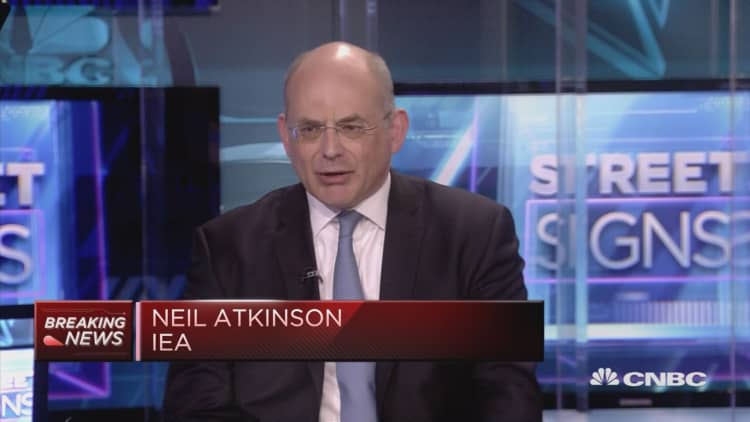
Oil prices have soared amid worries about fighting in the Middle East, but it is not yet clear whether elevated tensions will continue to support the recent rally, according to the latest monthly report from the International Energy Agency (IEA).
"Political uncertainty in the Middle East has returned to the fore," the IEA said in its closely-watched report published Friday.
"It remains to be seen if recently elevated prices are sustained and if so what are the implications for the market demand and supply dynamics," the Paris-based organization added.
Crude futures surged to highs not seen since December 2014 Wednesday, underpinned by greater geopolitical uncertainty in the Middle East and elevated concerns over the prospect of imminent military action from Western powers.
Oil prices have since edged away from multi-year highs, though both benchmarks were still on course to post their biggest weekly gain in more than eight months on Friday.
Missiles 'will be coming'
Brent crude was trading at $71.89 during early morning deals on Friday, down around 0.2 percent, while WTI traded at $66.96, approximately 0.15 percent lower. Both benchmarks have gained about $5 since the start of the week.
An uptick in prices follows incendiary comments from President Donald Trump Wednesday. The U.S. president tweeted missiles "will be coming," in response to a suspected chemical attack in Syria over the weekend.
Trump has since sought to dial back his explosive rhetoric, raising the prospect that an attack on Syria may not be as imminent as it first appeared earlier in the week.
Nonetheless, world leaders continue to weigh up military action in the war-torn country. Syria is not a major oil producer, especially after more than seven years of a full-scale civil war, but its allies Russia and Iran are both major global producers.
"It's mainly the fact that in Syria — and in Yemen for that matter — you have a potentially very combustible mix," Neil Atkinson, head of the oil industry and markets division at the IEA, told CNBC's "Street Signs" Friday.
"So obviously traders are becoming nervous about potential disruption to supply and that's helped drive the price back above $70 for Brent," he added.
Get ready for 'mission accomplished'
Meanwhile, in addition to greater geopolitical uncertainty in the Middle East, a further tailwind for oil prices of late has been an ongoing supply cut from major oil producing group OPEC and Russia, who started to withhold output in January last year.
The production cuts by OPEC and its allied non-OPEC oil producers, which are scheduled to last throughout 2018, are aimed at clearing a global supply overhang and propping up prices.
The IEA said while it was not for them to declare on behalf of OPEC whether its production cuts were beginning to look like "mission accomplished," the group said that assuming its own outlook for the energy market was accurate then "it certainly looks very much like it."
The IEA's forecast for oil demand this year was left unchanged at 99.3 million barrels per day (bpd) on Friday. The group's outlook for supply also remained the same, as it projected non-OPEC growth to reach 1.8 million bpd in 2018.


